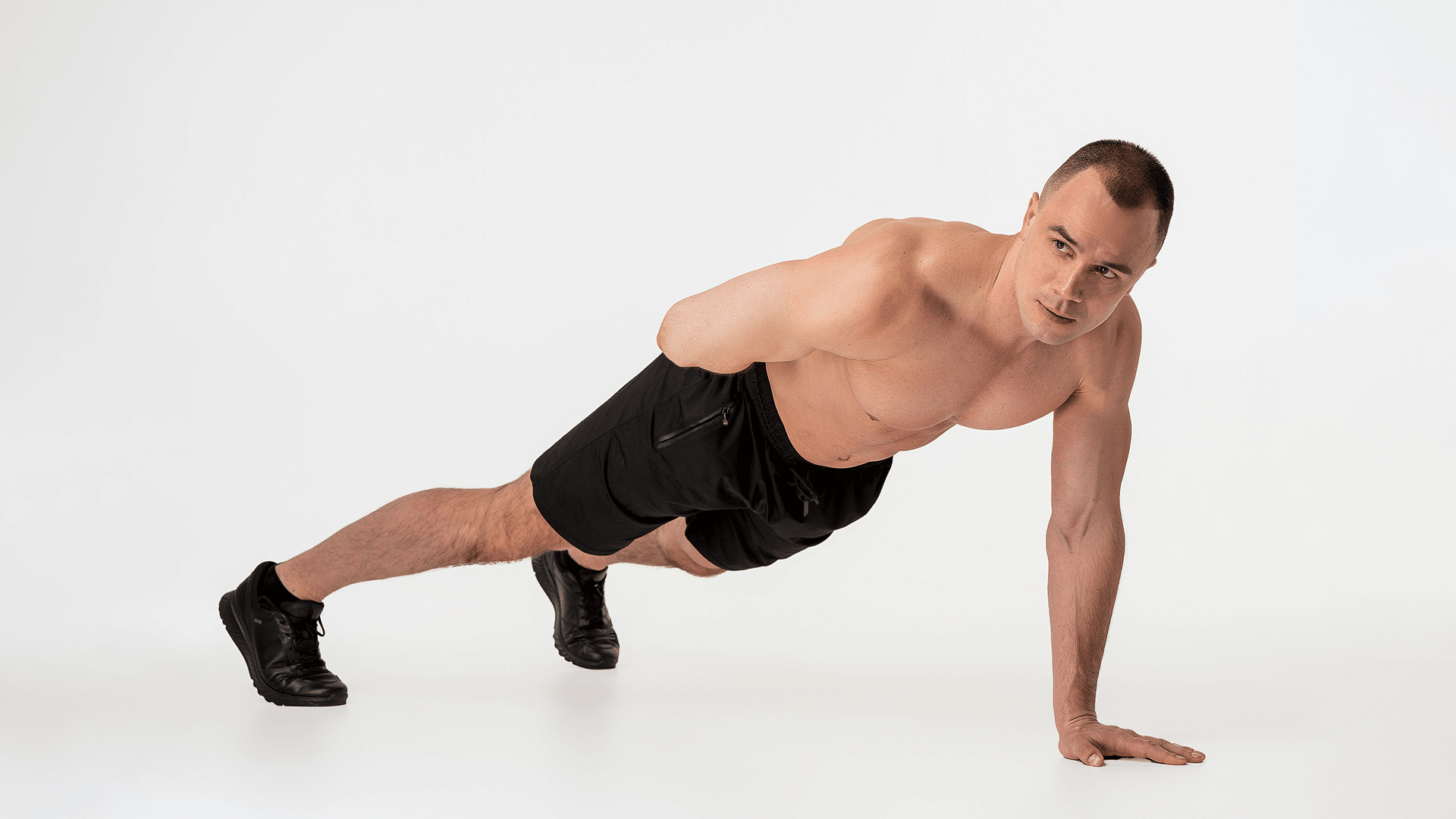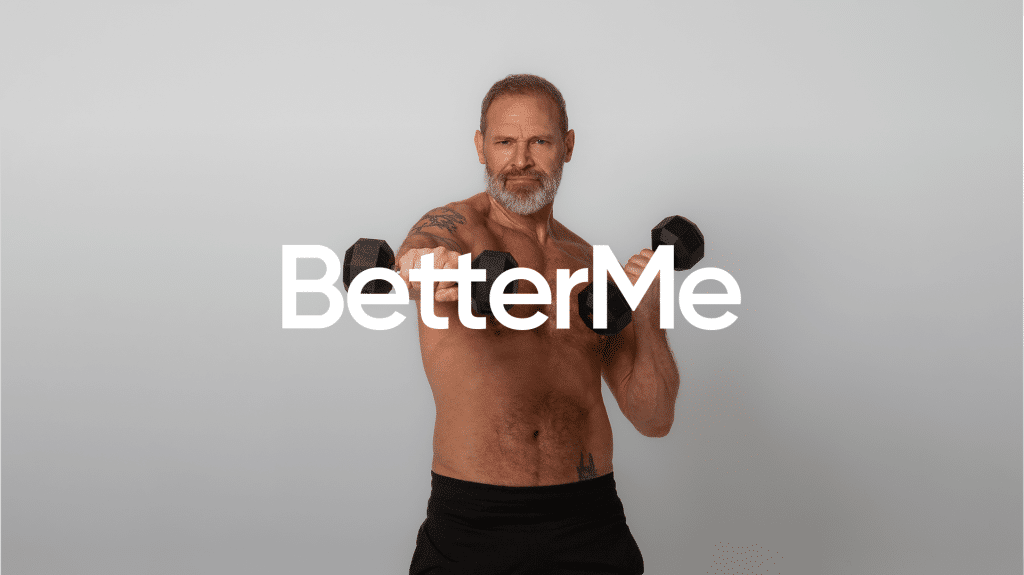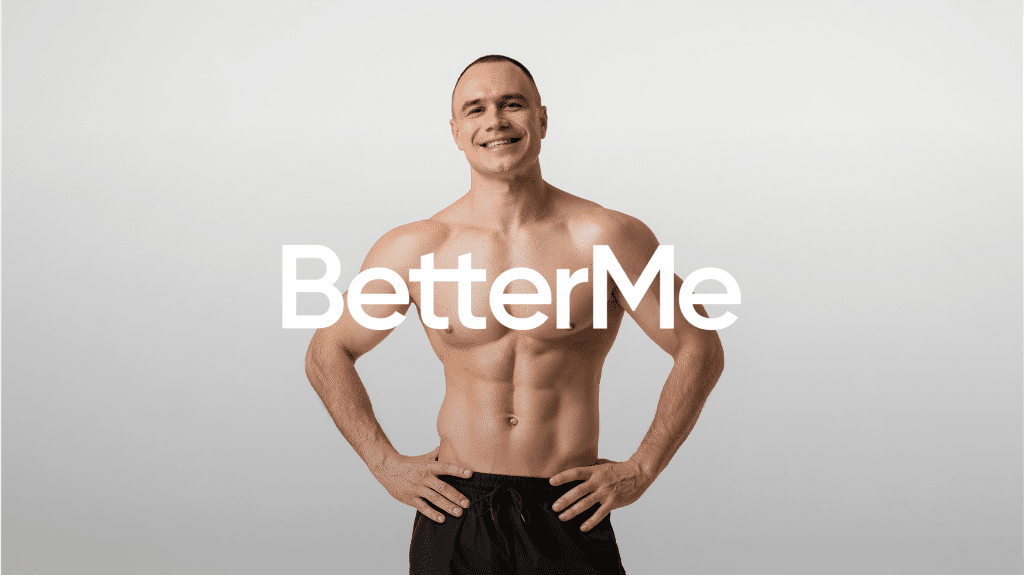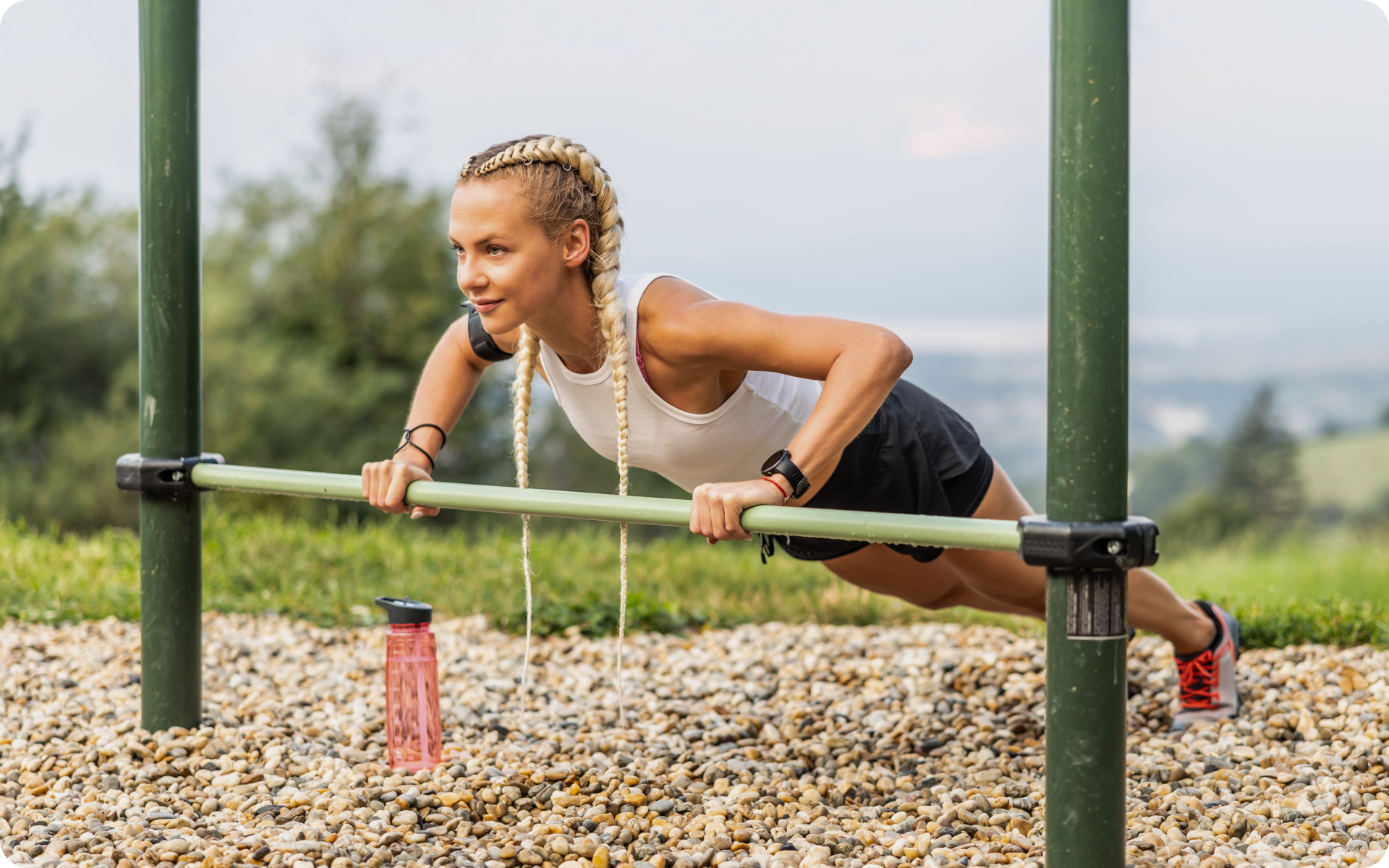Calisthenics is a unique discipline that utilizes your body weight as resistance for strength training, enabling a holistic approach to fitness (12). On top of that, it doesn’t require expensive gym memberships or fancy equipment, making it accessible to everyone. This workout routine will engage all your major muscle groups, helping you build strength, endurance, and flexibility. Whether you’re looking to tone up, lose weight, or simply get healthier, this routine presents a balanced workout to kickstart your fitness goals. Now, as a beginner, getting on a full-body calisthenics workout with no equipment can be a bit daunting. With that in mind, this workout is designed to ease you into the routine and build your strength gradually. In this post, you’ll find not only a full-body calisthenics workout plan but also an explanation of each exercise and how to execute it properly.
Full Body Calisthenics Workout for Beginners
Below, you’ll find a full body calisthenics workout plan designed specifically for beginners. This comprehensive program is perfect for those looking to engage in a full upper body calisthenics workout along with lower body exercises, creating a balanced approach to fitness.
The structure of the plan follows a calisthenics workout split, meaning that we’ll divide the exercises into different days to ensure each muscle group gets adequate attention and rest. Follow this full-body calisthenics workout 3 times a week, giving your body time to rest and recover on the other days.
This full body calisthenics workout routine for beginners will progressively challenge you, helping to build your strength and endurance over time. It’s more than just a workout; it’s a step-by-step guide to mastering the art of calisthenics.
The beauty of this plan is you only need your body weight and some determination; execute this full body calisthenics workout at home and skip the commute to the gym with its’ expensive membership fees.
Remember, consistency is key in this full-body bodyweight workout plan. Stick with it, and you’ll soon see improvements not only in your strength but also in your overall health and wellbeing.
Read More: Calisthenics Beginner Workout Plan: A Comprehensive Guide
A Beginner-Friendly Full Body Calisthenics Workout Routine
Here’s a beginner-friendly full-body calisthenics workout routine you can do at home:
Warm-Up
Begin with a 5-minute warmup. This could be a brisk walk, light jogging on the spot, or jumping jacks. The aim is to increase your heart rate and loosen up your muscles.
Push-Ups
Target Muscles: Chest, Triceps, Core
How to do it:
- Start in a high plank position with your hands flat on the ground positioned slightly wider than your shoulders. Your body should form a straight line from your head to your heels.
- Lower your body until your chest nearly touches the floor, ensuring your elbows are tucked close to your body. Push your body up, returning to the starting position.
Workout Plan: Perform 2 sets of 5-10 repetitions with a 60-second rest between sets.
Bodyweight Squats
Target Muscles: Quads, Glutes, Hamstrings
How to do it:
- Stand upright with your feet shoulder-width apart.
- Bend your knees and push your hips back as if you’re sitting on an imaginary chair.
- Ensure your chest stays upright and your knees track over your mid foot. Push back up to the starting position.
Workout Plan: Perform 3 sets of 15 repetitions with a 60-second rest between sets.
Forward Lunges
Target Muscles: Glutes, Quads, Hamstrings
How to do it:
- From a standing position, step forward with your right foot and lower your body until your right knee is at a 90-degree angle and your left knee is just above the floor. Ensure your front knee is directly above your ankle.
- Push back up and return to the starting position, then repeat with the other leg.
Workout Plan: Perform 2 sets of 8-12 repetitions (each leg) with a 60-second rest between sets.
Planks
Target Muscles: Core (Abs, Obliques, Lower Back)
How to do it:
- Begin in a forearm plank position with your forearms on the ground and your elbows directly below your shoulders.
- Your body should form a straight line from head to heels. Hold this position, keeping your core tight and your hips lifted.
Workout Plan: Hold the plank for 30 seconds. Rest for 30 seconds. Repeat this for 3 sets.
Jumping Jacks
Target Muscles: Full Body
How to do it
- Stand upright with your feet together and arms at your sides.
- Jump out spreading your feet wide and swinging your arms above your head, then jump back to the starting position.
Workout Plan: Perform 3 sets of 20 repetitions with a 30-second rest between sets.
BetterMe app will provide you with a host of fat-frying fitness routines that’ll scare the extra pounds away and turn your body into a masterpiece! Get your life moving in the right direction with BetterMe!
Cool Down
End your session with a 5-minute cool down. This could include stretching exercises to relax your muscles and slow down your heart rate.
Remember, it’s important to maintain proper form during all these exercises to prevent injury and maximize results. Over time as your fitness level improves, you can increase the number of sets or reps for each exercise. Aim to do this workout 3 times a week for optimal results.
How to Schedule Your Calisthenics Workouts
Day 1 – Workout
Kickstart your week with the first session. Make sure to follow the detailed exercise instructions and maintain proper form throughout. Start slow and gradually increase your intensity as your strength and endurance improve.
Day 2 – Rest
Rest days are crucial for muscle recovery and growth. You can engage in light activities like walking or stretching but avoid strenuous exercises. Light movement and activity can actually enhance and support optimal recovery.
Day 3 – Workout
Perform your second workout of the week. Try to increase your intensity from the first session, either by doing more reps, adding extra sets, or reducing rest time between sets.
Day 4 – Rest
Take another rest day to allow your muscles to recover. Light activities are fine, but make sure to get plenty of sleep and stay hydrated.
Day 5 – Workout
Perform the third and final workout of the week. Aim to push yourself a little more than the previous sessions. Remember, progress can be slow, so don’t get discouraged if improvements seem minimal.
Day 6 & Day 7 – Rest
Take two days off to fully recover before starting the cycle again. During these rest days, focus on replenishing your body with nutritious food and plenty of water.
Read More: The Only Guide For Back Workout Calisthenics You Need To Go From Novice To Pro
Is Full Body Good For Calisthenics?
Yes, a full body approach is not only good but can be highly beneficial for calisthenics. Here’s why:
Balanced Development
A full body calisthenics workout ensures balanced development of all muscle groups. It targets multiple muscle groups in a single session, promoting overall strength and functional fitness rather than focusing on isolated muscle groups (10).
Frequency
Unlike split routines where you might hit each muscle group once a week, a full body workout allows you to engage each muscle group multiple times in a week. This increased frequency can lead to better muscle stimulation and growth over time (2).
Functional Fitness
Calisthenics exercises often mimic natural movements we use in our daily lives (4). A full body approach enhances this aspect of functional fitness, which can improve your strength, flexibility, balance, and coordination in a way that benefits not just your workouts but your daily activities as well.
Efficiency
Full body workouts are typically more time-efficient. Since you’re working multiple muscle groups at once, you can get a comprehensive workout in a shorter amount of time, as compared to split routines (5).
Variety
Full body calisthenics workouts offer a wide variety of exercises, which can make your training sessions more interesting and enjoyable. This variety also challenges your body in different ways, which can promote continuous adaptation and progress (11).
Recovery
With full body workouts, you’re not overworking a specific muscle group in one session, which allows for adequate recovery time between workouts (7). Adequate recovery is crucial to prevent overtraining and injuries and to promote muscle growth and strength gains.
Remember, the best workout routine ultimately depends on your individual goals, fitness level, and preferences. Some might prefer split routines while others thrive on full body workouts. If you’re new to calisthenics, a full body workout can be a great place to start.
As you progress, you can always adjust your routine to better suit your evolving needs and goals.
Can You Do Full Body Calisthenics Workouts Everyday?
While it’s technically possible to do full body calisthenics every day, it’s generally not recommended for several reasons:
Your body needs time for muscle recovery
When you exercise, especially strength training exercises like calisthenics, you create microscopic tears in your muscle fibers (8). Your body repairs these tears during rest periods, leading to muscle growth and strength gains.
Without adequate rest, your muscles don’t have time to repair and grow, which can limit your progress and increase the risk of injury.
Overtraining may decrease performance
Exercising every day without adequate rest can lead to overtraining, a state where you’re not only physically exhausted but also mentally fatigued.
Symptoms of overtraining can include decreased performance, increased resting heart rate, disrupted sleep, and decreased immunity (6).
Balanced routine is important for progress
Fitness is not just about strength training. It’s also important to incorporate cardio, flexibility training, and rest days into your routine for a balanced approach to health and fitness.
That being said, light or moderate intensity calisthenics exercises could potentially be done daily if they’re part of a well-rounded fitness routine and you’re listening to your body’s signals.
For instance, doing a few sets of push-ups or squats every day can be beneficial as long as you’re not pushing to failure each time and you’re allowing for recovery if you start to feel overly fatigued or sore.
However, for most people, especially beginners, it’s usually recommended to start with 3 full body calisthenics workouts per week, allowing for a rest day between each workout.
As your fitness level improves, you can adjust your routine as needed, but always make sure to include rest days for optimal recovery and progress.
BetterMe will keep you laser-focused on your weight loss journey! Nutrient-packed meal plans, fat-blasting workouts, galvanizing challenges and much more. Try using the app and see for yourself!
Can You Train All Muscles With Full Body Calisthenics Workouts?
Yes, calisthenics is an effective way of working every major muscle group in your body. You’re using your own body weight as resistance, and with the right exercises you can target all muscle groups.
For the upper body, exercises such as push-ups, pull-ups, dips, and handstands are highly effective. They work on your chest, back, shoulders, and arm muscles, including biceps and triceps. Exercises like planks, leg raises, Russian twists, and mountain climbers are excellent choices to target the core, which includes your abs, obliques, and lower back.
As for the lower body, squats, lunges, glute bridges, and pistol squats are great calisthenics exercises that can help you develop strength and definition in your glutes, quads, hamstrings, and calves.
One key element to ensure a successful calisthenics program is variety. By incorporating a wide range of exercises into your routine, you can ensure that you’re working all muscle groups evenly and effectively. Another advantage of calisthenics is the scalability. Regardless of your fitness level, you can adjust the intensity and effectiveness of the exercises. For instance, beginners can start with knee push-ups or assisted pull-ups, while those at an advanced level can challenge themselves with one-arm push-ups or muscle-ups.
Are Full Body Calisthenics Workouts Safer Than Weights?
The safety of calisthenics versus weights largely depends on the individual’s technique, form, and understanding of their own physical limits.
Calisthenics, which involves exercises that use your own body weight for resistance, can be a safe and effective strength training method, especially for beginners (13). You’re less likely to drop a heavy weight on yourself or push into dangerous amounts of weight. Calisthenics also promote better balance, flexibility, and joint mobility which can lead to fewer injuries overall.
However, this doesn’t mean that calisthenics are completely risk-free. Performing these exercises with improper form or pushing beyond your physical limits can still lead to strains, sprains, or other injuries (3).
On the other hand, weightlifting, when done correctly and responsibly, can also be safe. It allows for more controlled and specific muscle targeting which can be beneficial for building strength and muscle mass. However, lifting heavy weights with poor form or without proper warm-up can increase the risk of injury (1).
Regardless of the type of workout, it’s important to learn and maintain proper form, listen to your body, and avoid pushing beyond your capacity to reduce the risk of injury. If you’re new to either form of exercise, it may be beneficial to work with a trainer or coach initially to ensure you’re performing the exercises correctly.
FAQs
How to develop a full body calisthenics workout plan?
Start by identifying exercises for each major muscle group: upper body, lower body, and core.
Choose 2-3 exercises for each group. Plan to workout 3 times a week, allowing for rest days in between. Each session should include exercises for all muscle groups. Remember to start with a warm-up and end with a cool-down.
How many sets and reps for full body calisthenics workout?
A general guideline is to perform 3-4 sets of each exercise with 8-12 repetitions per set. This can vary depending on your fitness level and goals. Beginners may start with fewer sets and reps, while more advanced individuals may aim for more.
How much muscle can you build with only calisthenics?
The amount of muscle you can build with calisthenics depends on various factors like your nutrition, consistency, intensity of workouts, and genetics (9).
While you might not achieve the same bulk as weightlifting, calisthenics can definitely help you build lean muscle mass and improve functional strength.
Can you do calisthenics everywhere?
Yes, one of the benefits of calisthenics is its convenience and flexibility. Since these exercises use your own body weight for resistance, they can be done anywhere – at home, in a park, or while traveling, with minimal or no equipment needed.
Conclusion
This full-body approach not only helps in building strength and endurance, but it also improves balance, agility, and flexibility. Remember, starting with simple exercises and gradually increasing intensity and complexity is the key to successful calisthenics training.
DISCLAIMER:
This article is intended for general informational purposes only and does not serve to address individual circumstances. It is not a substitute for professional advice or help and should not be relied on for making any kind of decision-making. Any action taken as a direct or indirect result of the information in this article is entirely at your own risk and is your sole responsibility.
BetterMe, its content staff, and its medical advisors accept no responsibility for inaccuracies, errors, misstatements, inconsistencies, or omissions and specifically disclaim any liability, loss or risk, personal, professional or otherwise, which may be incurred as a consequence, directly or indirectly, of the use and/or application of any content.
You should always seek the advice of your physician or other qualified health provider with any questions you may have regarding a medical condition or your specific situation. Never disregard professional medical advice or delay seeking it because of BetterMe content. If you suspect or think you may have a medical emergency, call your doctor.
SOURCES:
- An epidemiologic study of sports and weight lifting as possible risk factors for herniated lumbar and cervical discs. The Northeast Collaborative Group on Low Back Pain (1993, nih.gov)
- Benefits of Physical Activity (2022, cdc.gov)
- Calisthenics: Epidemiology of Injury Patterns and Their Risk Factors (2023, nih.gov)
- Calisthenics: The Many Benefits Explained (2023, inspireusafoundation.org)
- No Time to Lift? Designing Time-Efficient Training Programs for Strength and Hypertrophy: A Narrative Review (2021, nih.gov)
- Overtraining Syndrome (2012, nih.gov)
- Overtraining: What It Is, Symptoms, and Recovery (2023, hss.edu)
- Physiology, Exercise (2022, nih.gov)
- Resistance training – health benefits (2021, betterhealth.vic.gov)
- Split or full-body workout routine: which is best to increase muscle strength and hypertrophy? (2021, nih.gov)
- The advantages of body-weight exercise (2022, harvard.edu)
- The effects of a calisthenics training intervention on posture, strength and body composition (2017, researchgate.net)
- Which resistance training is safest to practice? A systematic review (2023, nih.gov)















